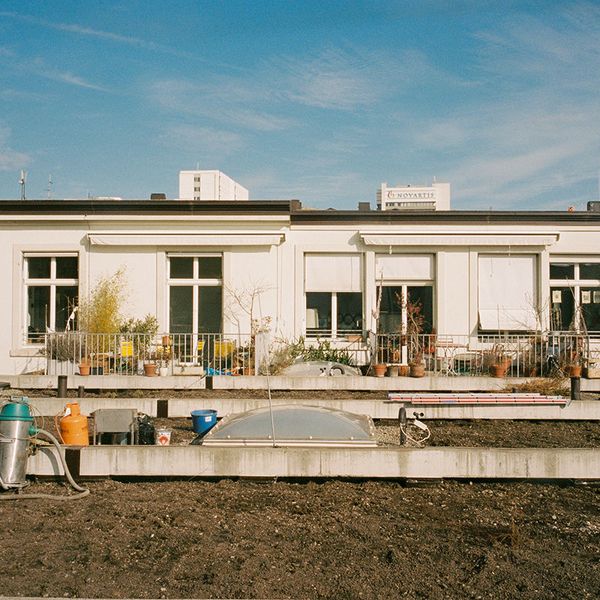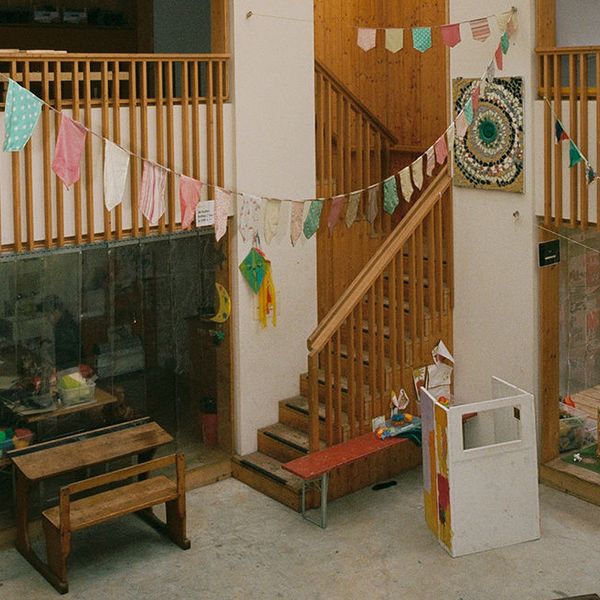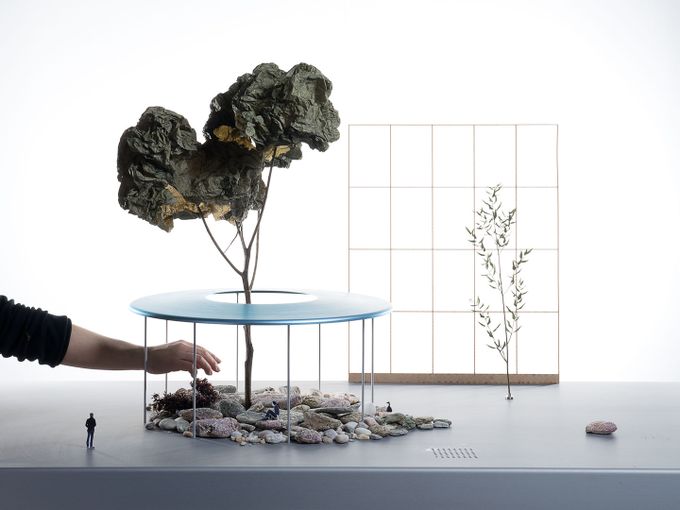Better Together
An exhibition on collective living is on show at the Vitra Design Museum

How do we want to live together in the future? A new exhibition in the Vitra Design Museum addresses a silent revolution that has taken place in the contemporary architecture of the last few years – a movement towards collective building and living.
A quick glance into three of these exemplary projects from across the world proves: communal living is sustainable, cost-effective and makes us all happier.
A quick glance into three of these exemplary projects from across the world proves: communal living is sustainable, cost-effective and makes us all happier.
Project 1: Musikerwohnhaus, Basel, Switzerland

TOTAL FLOOR AREA: 2099 M2
COMMUNAL SPACES: 506 M2
COST PER M2 FLOOR AREA: N.A.
This development transforms a former factory building into an unusual community reserved solely for musicians. Funded by the Swiss Habitat Foundation, which specialises in housing solutions for people with unusual needs, this project is meant to resolve a longstanding problem for musicians living in conventional housing: when you have thin walls and sensitive neighbours, it’s hard to find space and time to practice your instrument. The Musikerwohnhaus places soundproofed practice rooms right outside residents’ doors, allowing them to practice to their heart’s content at all hours of night and day. The practice rooms are complemented by a cafeteria, guest apartments, and four additional, larger practice rooms that can also be used as recording studios.
COMMUNAL SPACES: 506 M2
COST PER M2 FLOOR AREA: N.A.
This development transforms a former factory building into an unusual community reserved solely for musicians. Funded by the Swiss Habitat Foundation, which specialises in housing solutions for people with unusual needs, this project is meant to resolve a longstanding problem for musicians living in conventional housing: when you have thin walls and sensitive neighbours, it’s hard to find space and time to practice your instrument. The Musikerwohnhaus places soundproofed practice rooms right outside residents’ doors, allowing them to practice to their heart’s content at all hours of night and day. The practice rooms are complemented by a cafeteria, guest apartments, and four additional, larger practice rooms that can also be used as recording studios.
Taking advantage of the generous dimensions of the former industrial building, two apartments encompass up to seven rooms and are meant for several households (mostly students) to live together. In the newly built double-height, sky-lit play house for children, three of the exterior walls can be retracted to open the space up to the complex’s interior courtyard. With its juxtaposition of various living forms and facilities in a complex sequence of open and exposed spaces, the Musikerwohnhaus goes beyond its novelty as “housing for musicians”, managing to successfully create the feeling of a vibrant neighbourhood within a neighbourhood.
Project 2: Spreefeld Berlin, Berlin, Germany

TOTAL USABLE FLOOR AREA: 8000 M2
COMMUNAL SPACES: 1154 M2
COST PER M2 FLOOR AREA: 1800 EUR
Spreefeld Berlin is a housing development in Berlin along the banks of the River Spree, planned and realised according to a cooperative model by its residents. The complex was conceived of as a built argument against plans for a high-density, monofunctional, and profitoriented development along the river. Occupying the site of a former Berlin club, the Kiki Blofeld beach bar, Spreefeld comprises three passivehouse- standard blocks, all with views to the river. The grounds and gardens are fully accessible as public space, while three “option spaces” on the ground level of each block are available for use by non-residents.
COMMUNAL SPACES: 1154 M2
COST PER M2 FLOOR AREA: 1800 EUR
Spreefeld Berlin is a housing development in Berlin along the banks of the River Spree, planned and realised according to a cooperative model by its residents. The complex was conceived of as a built argument against plans for a high-density, monofunctional, and profitoriented development along the river. Occupying the site of a former Berlin club, the Kiki Blofeld beach bar, Spreefeld comprises three passivehouse- standard blocks, all with views to the river. The grounds and gardens are fully accessible as public space, while three “option spaces” on the ground level of each block are available for use by non-residents.


Spreefeld offers a special typology in the form of five expansive cluster apartments. Ranging from 180 to 820 square metres and home to between 4 and 21 people, these units allow private and public space to be cohabitees: private living quarters, each meant for one household and equipped with its own bathroom and kitchenette, are arranged around communal living and dining areas. In this way, the ethos of a close-knit, social community underpinning the whole project is maintained while still offering cluster apartment dwellers privacy as and when needed.
In the cluster, some sort of community dinner is usually held every evening, with larger dinner events organised once or twice a week. Cupboards in the communal kitchen are labelled so that no one puts dishes away in the wrong place. The cluster subscribes to a community-supported agriculture scheme, which delivers fresh produce every week. This forms the basis for the week’s cooking. Staple foods are bought by the collective and divided up. The basis for the calculations is a “kitchen book”, where each member records what he or she has consumed.
Outside is another work in progress: The residents hope one day to grow their own produce in this greenhouse, with help from the radiant heat from the heating facility below.
Outside is another work in progress: The residents hope one day to grow their own produce in this greenhouse, with help from the radiant heat from the heating facility below.
Project 3: Moriyama Haus, Tokyo, Japan

TOTAL FLOOR AREA: 263 M2
COMMUNAL SPACES: 160 M2 (COURTYARD)
COST PER M2 FLOOR AREA: N.A.
The Moriyama House explodes a typical detached home into its constituent elements, scattering them seemingly haphazardly across the lot. Ten rooms are rendered as ten separate structures, as a group of white cubes clustered in a garden. The owner of the property occupies one corner of the arrangement, while renting out a number of the other rooms, which range from sixteen to thirty-two square metres. Inspiration for the arrangement stems from the surrounding neighbourhood, a typically dense, timber-construction residential area of Tokyo, where the narrow alleyways serve not merely as spaces to move through, but also as places where everyday life and activity spills out from the surrounding homes. The constellational setup of the Moriyama House means that small gardens take the place of internal corridors: for residents, even the simple act of taking a shower requires taking a stroll outside. One might run into a neighbour, become party to gossip, catch a glimpse of the goings-on in the larger community. What results is a neighbourhood within a neighbourhood – a “home” that has been freed from its conventionally monolithic definition to become, in effect, the city itself.
COMMUNAL SPACES: 160 M2 (COURTYARD)
COST PER M2 FLOOR AREA: N.A.
The Moriyama House explodes a typical detached home into its constituent elements, scattering them seemingly haphazardly across the lot. Ten rooms are rendered as ten separate structures, as a group of white cubes clustered in a garden. The owner of the property occupies one corner of the arrangement, while renting out a number of the other rooms, which range from sixteen to thirty-two square metres. Inspiration for the arrangement stems from the surrounding neighbourhood, a typically dense, timber-construction residential area of Tokyo, where the narrow alleyways serve not merely as spaces to move through, but also as places where everyday life and activity spills out from the surrounding homes. The constellational setup of the Moriyama House means that small gardens take the place of internal corridors: for residents, even the simple act of taking a shower requires taking a stroll outside. One might run into a neighbour, become party to gossip, catch a glimpse of the goings-on in the larger community. What results is a neighbourhood within a neighbourhood – a “home” that has been freed from its conventionally monolithic definition to become, in effect, the city itself.


The exhibition “Together! The New Architecture of the Collective” is curated by Ilka and Andreas Ruby and EM2N. It’s on show until 10 September 2017. More projects, ideas and images are also available in the Vitra Design Museums’s catalogue.
Publication date: 06. July 2017, first published in the Vitra Design Museum’s exhibition catalogue ‘Together. The New Architecture of the Collective’, June 2017.
Publisher: Mateo Kries, Mathias Müller, Daniel Niggli, Andreas Ruby, Ilka Ruby
Images: Star Apartments, Los Angeles; © Gabor Ekecs, 2014; Copyright: Michael Maltzan Architecture. Musikerwohnhaus and Spreefeld: © Daniel Burchard, 2017; Copyright: Vitra Design Museum. Moriyama House: © Edmund Sumner/VIEW, © Dean Kaufman; Copyright: Office of Ryue Nishizawa, Tokio, 2005








